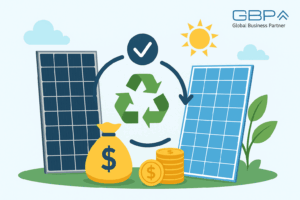01 A burgeoning industry
As the solar-photovoltaic (PV) fleet across the globe matures, one of the unsung challenges of the clean-energy transition is rapidly coming into sharp focus: what happens when solar panels reach the end of their useful life?
According to the International Renewable Energy Agency (IRENA), cumulative PV-panel waste is projected to grow from just 0.2 million tonnes in 2021 to roughly 4 million tonnes by 2030—and could exceed 200 million tonnes by 2050 under its 1.5 °C scenario. This burgeoning waste stream presents not only an environmental headache but a major business opportunity for companies specialising in solar-system repowering, refurbishment and recycling.
02 Why repowering demands a circular mindset
For owners of aging solar systems, replacing older panels isn’t just about restoring performance—it’s about doing so responsibly and economically. Many panels installed a decade or more ago contain materials such as aluminium, glass and copper, and increasingly valuable commodity inputs such as silver and silicon. A recent National Renewable Energy Laboratory (NREL) review notes that over 85 % of a typical crystalline-silicon module’s mass consists of materials already well-suited for recycling. Yet despite this, recycling, reuse and second-life systems remain under-developed: many decommissioned modules still end up in landfills, particularly in regions lacking regulation or infrastructure.
03 What the repowering specialist must do
To turn this potential into reality, repowering must shift from a purely “swap-old-for-new” mindset to a system-level approach that includes audit, reuse, retrofit and recycling. That means:
• Assessing the condition of existing panels for reuse or second life, rather than immediately replacing them.
• Partnering with or building recycling solutions that recover high-value materials (glass purity, silicon, silver) rather than simply crushing modules.
• Designing replacement systems and mounting structures for future disassembly and repair—so they are circular from the outset.
• Planning logistics and certification for end-of-life handling, especially in jurisdictions where landfill bans or take-back schemes are emerging.
04 Why this matters now
Beyond the environmental imperative, investors and regulators are increasingly demanding circularity in renewable-energy projects. In Australia, for example, experts warn that solar-panel waste will reach “crisis levels” within two to three years, unless reuse and recycling scale rapidly. For a company like GBP, whose core business is matching replacement panels to existing systems, integrating recycling offers a competitive edge: by demonstrating responsible end-of-life management, the company not only supports clients’ O&M and repowering efforts, but also contributes to ESG compliance, cost avoidance and long-term performance assurance.
In short, when ageing solar arrays are replaced, the smartest players won’t simply discard the old modules—they will recover them, reuse what they can, recycle what they must, and treat the process as a value-chain opportunity. In doing so, they close the loop and show that circular economy thinking is not only ethically right—it makes business sense.

